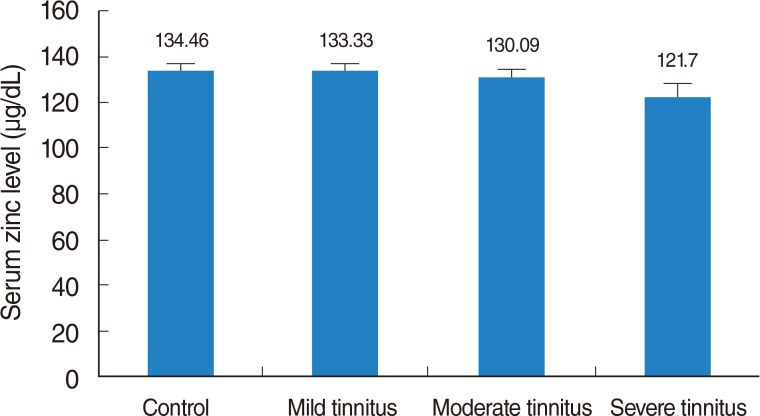1. Moller AR. Tinnitus: presence and future. Prog Brain Res. 2007; 166:3–16. PMID:
17956767.
2. Patterson MB, Balough BJ. Review of pharmacological therapy for tinnitus. Int Tinnitus J. 2006; 12(2):149–159. PMID:
17260881.
3. Salvi R, Lobarinas E, Sun W. Pharmacological treatments for tinnitus: new and old. Drugs Future. 2009; 34(5):381–400. PMID:
21765586.

4. Zirpel L, Parks TN. Zinc inhibition of group I mGluR-mediated calcium homeostasis in auditory neurons. J Assoc Res Otolaryngol. 2001; 6. 2(2):180–187. PMID:
11550527.

5. Rarey KE, Yao X. Localization of Cu/Zn-SOD and Mn-SOD in the rat cochlea. Acta Otolaryngol. 1996; 11. 116(6):833–835. PMID:
8973716.

6. Speich M, Pineau A, Ballereau F. Minerals, trace elements and related biological variables in athletes and during physical activity. Clin Chim Acta. 2001; 10. 312(1-2):1–11. PMID:
11580904.

7. McFadden SL, Ding D, Burkard RF, Jiang H, Reaume AG, Flood DG, et al. Cu/Zn SOD deficiency potentiates hearing loss and cochlear pathology in aged 129,CD-1 mice. J Comp Neurol. 1999; 10. 413(1):101–112. PMID:
10464373.

8. Arda HN, Tuncel U, Akdogan O, Ozluoglu LN. The role of zinc in the treatment of tinnitus. Otol Neurotol. 2003; 1. 24(1):86–89. PMID:
12544035.

9. Ochi K, Ohashi T, Kinoshita H, Akagi M, Kikuchi H, Mitsui M, et al. The serum zinc level in patients with tinnitus and the effect of zinc treatment. Nihon Jibiinkoka Gakkai Kaiho. 1997; 9. 100(9):915–919. PMID:
9339660.

10. Shambaugh GE Jr. Zinc and presbycusis. Am J Otol. 1985; 1. 6(1):116–117. PMID:
3976852.
11. Yetiser S, Tosun F, Satar B, Arslanhan M, Akcam T, Ozkaptan Y. The role of zinc in management of tinnitus. Auris Nasus Larynx. 2002; 10. 29(4):329–333. PMID:
12393036.

12. Paaske PB, Pedersen CB, Kjems G, Sam IL. Zinc in the management of tinnitus. Placebo-controlled trial. Ann Otol Rhinol Laryngol. 1991; 8. 100(8):647–649. PMID:
1872515.
13. Coelho C, Witt SA, Ji H, Hansen MR, Gantz B, Tyler R. Zinc to treat tinnitus in the elderly: a randomized placebo controlled crossover trial. Otol Neurotol. 2013; 8. 34(6):1146–1154. PMID:
23598691.
14. Gersdorff M, Robillard T, Stein F, Declaye X, Vanderbemden S. A clinical correlation between hypozincemia and tinnitus. Arch Otorhinolaryngol. 1987; 244(3):190–193. PMID:
3675302.

15. Hotz C, Peerson JM, Brown KH. Suggested lower cutoffs of serum zinc concentrations for assessing zinc status: reanalysis of the second National Health and Nutrition Examination Survey data (1976-1980). Am J Clin Nutr. 2003; 10. 78(4):756–764. PMID:
14522734.

16. Gibson RS. Principles of nutritional assessment. New York: Oxford University Press;2005.
17. Chung DY, Gannon RP, Mason K. Factors affecting the prevalence of tinnitus. Audiology. 1984; 23(5):441–452. PMID:
6487142.
18. Hoffman HJ, Reed GW. Epidemiology of tinnitus. In : Show JB, editor. Tinnitus: theory and management. Hamilton (ON): BC Decker;2004. p. 16–41.
19. Hazell J. Tinnitus and disability with ageing: adaptation and management. Acta Otolaryngol (Stockh). 1991; 111(Suppl 476):202–208.

20. Nondahl DM, Cruickshanks KJ, Wiley TL, Klein R, Klein BE, Tweed TS. Prevalence and 5-year incidence of tinnitus among older adults: the epidemiology of hearing loss study. J Am Acad Audiol. 2002; 6. 13(6):323–331. PMID:
12141389.

21. Sindhusake D, Golding M, Newall P, Rubin G, Jakobsen K, Mitchell P. Risk factors for tinnitus in a population of older adults: the blue mountains hearing study. Ear Hear. 2003; 12. 24(6):501–507. PMID:
14663349.

22. Shambaugh GE Jr. Zinc for tinnitus, imbalance, and hearing loss in the elderly. Am J Otol. 986; 11. 7(6):476–477. PMID:
3492920.
23. King JC. Assessment of zinc status. J Nutr. 1990; 11. 120(Suppl 11):1474–1479. PMID:
2243291.

24. Tyler R, Coelho C, Tao P, Ji H, Noble W, Gehringer A, et al. Identifying tinnitus subgroups with cluster analysis. Am J Audiol. 2008; 12. 17(2):S176–S184. PMID:
19056922.






 PDF
PDF Citation
Citation Print
Print


 XML Download
XML Download